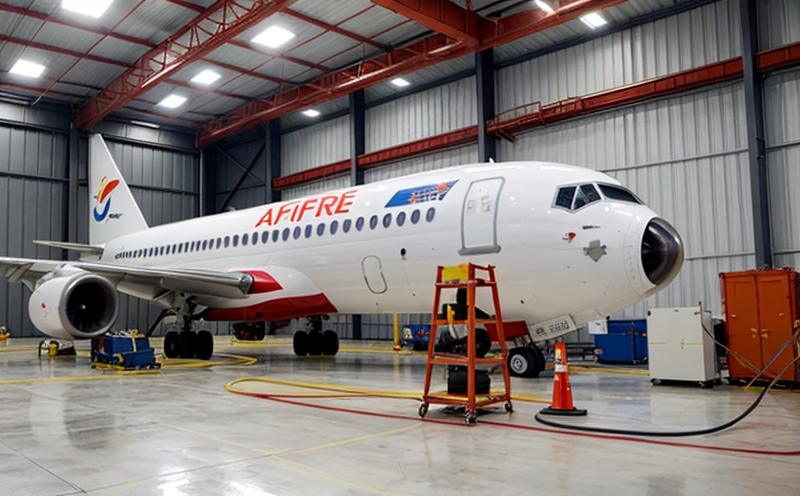Heat Release Rate Testing of Aircraft Interior Panels
The heat release rate (HRR) testing of aircraft interior panels is a critical component in ensuring fire safety within commercial and military aerospace applications. This test evaluates how quickly an ignitable material releases heat when exposed to fire, which directly impacts the time required for smoke detectors to activate or for passengers to evacuate safely. The aerospace industry places stringent requirements on materials used in aircraft interiors due to the high density of people and critical equipment.
Compliance with standards such as ISO 16337-2:2015 ensures that interior panels meet the necessary fire safety criteria, thereby protecting passengers and crew from potential hazards. The test is conducted on various types of materials used in aircraft interiors, including textiles, composites, and foams, to assess their flammability characteristics.
The testing process involves subjecting a specimen cut to standard dimensions to specific environmental conditions—such as temperature, humidity, and oxygen concentration—to simulate real-world scenarios. The apparatus used includes a convection calorimeter which measures the heat released during combustion. This allows for precise quantification of HRR values, critical for understanding material behavior under fire.
Preparation of specimens is crucial; they are cut to standard sizes ensuring accurate testing and comparison with previous results. Proper sample preparation ensures reproducibility and reliability of test data. After the test, the calorimeter provides a report detailing the HRR over time, which is used by quality managers and compliance officers to ensure the materials meet safety standards.
The importance of this test cannot be overstated; it directly influences passenger safety during emergencies. By ensuring that interior panels do not release excessive heat, the risk of fire spreading throughout the aircraft is minimized. This, in turn, enhances overall aviation safety by preventing potential accidents and saving lives.
It's worth noting that HRR testing aligns with broader industry standards aimed at reducing fire risks within commercial and military aircraft interiors. Compliance with these standards is not only a regulatory requirement but also an essential part of the design process for aerospace manufacturers.
Scope and Methodology
| Test Parameters | Description |
|---|---|
| Specimen Preparation | Cut to standard dimensions ensuring accurate testing. |
| Environmental Conditions | Controlled temperature, humidity, and oxygen concentration simulating real-world conditions. |
| Instrumentation | Convection calorimeter for measuring heat release rates. |
| Data Collection | Continuous measurement of HRR over time using the calorimeter. |
| Reporting | Detailed report including HRR values at different stages of combustion. |
The process begins with the preparation of specimens cut to standard dimensions, ensuring accuracy and consistency across tests. The specimens are then exposed to controlled environmental conditions—temperature, humidity, and oxygen concentration—all designed to simulate real-world scenarios as closely as possible. The convection calorimeter measures the heat released during combustion, providing precise data on HRR over time.
The calorimeter records continuous measurement of HRR at various stages of combustion, which is then analyzed by quality managers and compliance officers. This comprehensive approach ensures that materials used in aircraft interiors meet stringent safety standards set forth by industry regulations and guidelines.
Why Choose This Test
Heat release rate (HRR) testing of aircraft interior panels is crucial for ensuring the highest level of fire safety within commercial and military aerospace applications. The test provides critical data that helps in selecting materials that meet or exceed industry standards, thereby enhancing overall aviation safety.
- Promotes Passenger Safety: Ensures that materials used do not release excessive heat during a fire event, minimizing the risk of rapid fire spread and improving passenger survival rates.
- Meets Regulatory Requirements: Compliance with standards such as ISO 16337-2:2015 ensures that interior panels meet necessary safety criteria.
- Enhances Design Process: Provides insights into material behavior under fire, allowing for informed design decisions and continuous improvement of aircraft interiors.
- Precise Data Collection: The convection calorimeter provides accurate HRR data at various stages of combustion, ensuring reliable and reproducible test results.
- Supports Quality Assurance: Regular testing ensures that materials consistently meet safety standards, supporting continuous quality assurance initiatives.
The rigorous nature of HRR testing underscores its importance in the aerospace industry. By adhering to these tests, manufacturers can rest assured that their products not only comply with regulatory requirements but also contribute significantly to enhancing passenger and crew safety during emergency situations.
Use Cases and Application Examples
- Aircraft Interior Design: Used in the early stages of aircraft interior design to select materials that meet fire safety standards.
- Material Development: Helps R&D engineers develop new materials with improved fire resistance properties.
- Safety Assessment: Essential for evaluating existing materials and identifying areas for improvement in current designs.
- Compliance Verification: Used to verify compliance with industry standards such as ISO 16337-2:2015.
- Quality Assurance: Regular testing ensures that materials consistently meet safety standards, supporting continuous quality assurance initiatives.
- Emergency Response Planning: Provides valuable data for emergency response planning and training programs.
The results of HRR tests are invaluable to various stakeholders within the aerospace industry. From designers seeking to innovate with new materials to compliance officers ensuring adherence to safety regulations, this test plays a pivotal role in maintaining the highest standards of fire safety in aircraft interiors.





